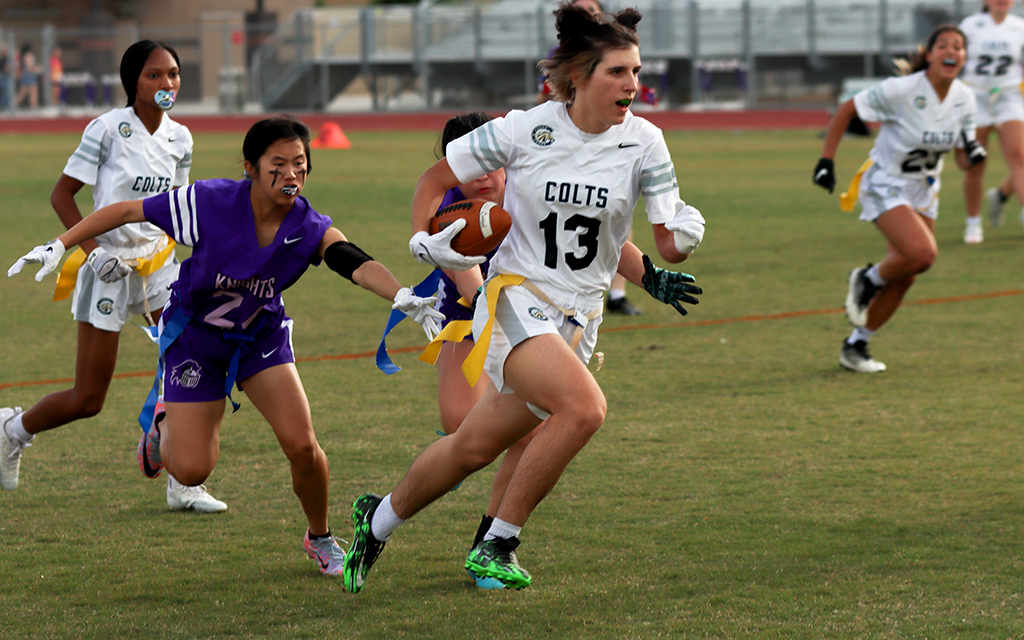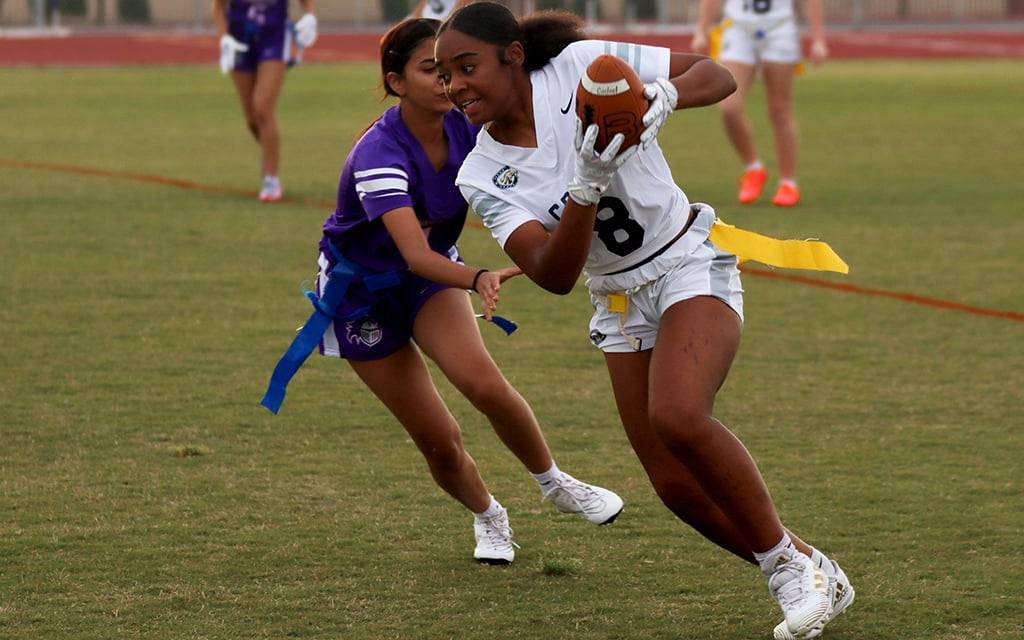PHOENIX – With support from the NFL, flag football is booming.
It is rapidly growing at the youth and high school levels in the United States. Programs are sprouting across the globe. Flag football might even be coming to the Olympics in the near future.
And it is coming to high schools in Arizona this fall.
The Arizona Interscholastic Association, the governing body for high school sports in the state, will recognize girls flag football as a sanctioned sport in the fall, joining a handful of states including Nevada, California and New York that have quickly moved to add the sport.
Arizona is fast-tracking flag football and brings a unified rulebook, which the AIA created along with help from a mix of other states. Most schools have existing facilities for football and equipment for the flag game is minimal and inexpensive, making it as close to a plug-and-play sport as there is.
Seth Polansky, the AIA’s director of sports information, said the AIA sanctioned flag football without even requiring an exploratory period because of the number of schools will be able to field teams in the inaugural season.
One of the key contributors in bringing the sport to its current status is Rae Black, coach of the Casteel Colts girls flag football team. Black, who played flag football in college, was a key leader of a board that included Hamilton coach Matt Stone and was critical in getting the sport straight to its “sanctioned” status.
Black, leading the rapid construction of Casteel’s flag program, detailed several present challenges on top of building the metaphorical plane during take-off.
“Being a woman amongst a male-ran sport in a male-ran coaching staff, it makes it a little difficult. I feel like there’s this stereotype of ‘You don’t really know what you’re talking about,’” Black said. “There’s always like, some type of comment, or some type of stereotype that is put on you. I feel like that is my biggest challenge. But that’s also my biggest motivation.”
The sport’s sudden growth and acceptance provides new opportunities across the country, but Black pointed out how a lack of collaboration could create fragmentation that makes interstate play problematic.
“I think the main thing that makes it tough is that every state has different rules, which makes it hard for you to play another state. The rules are very, very different in California or New York,” Black said.
These sort of cross-state-line games are a significant part of the seasons of top high school tackle football programs. Systems like the National Football League’s NFL FLAG or USA Football aim to provide some clarity and consistency with standardized rule books and programs, although as Black said, “Every state does its own thing.”
Arizona’s quick adoption of girls flag football on the high school level reflects the rapidly expanding popularity of the sport.
There is already a push to give flag football athletes the opportunity to compete for scholarships and take their talents to colleges and universities.
The National Association of Interscholastic Athletics (NAIA) gave flag football “emerging sport” status in 2020, describing its rapid growth as “unprecedented.”
And flag football is benefiting from a significant effort to promote it as an option to tackle football with support from the NFL and the International Federation of American Football (IFAF) and its 72 member nations.
Peter O’Reilly, NFL executive vice president, club business, international and league events, said the league is committed to support of the flag game, “because it is so accessible to girls and boys, men and women. It’s so inexpensive to start to play and there are so few barriers.”
O’Reilly recently focused on flag football’s importance to the NFL during the league’s annual meetings at the Arizona Biltmore, highlighting the NFL’s changes to its Pro Bowl format to a skills competition and a flag football game rather than full-contact Pro Bowl Game of the past.
During the week leading up to the event, the NFL also brought in youth flag football programs from around the world to compete at the NFL Flag Championships, with teams representing local programs run by NFL clubs or national programs from countries around the world, including Germany, the United Kingdom, Mexico, Japan and Australia.
The IFAF expects 2023 to be the year that flag football will exceed tackle football in total participation primarily because of the significant strides flag football has made internationally.

Casteel wide receiver Kate Berg gets her yards-after-carry during a recent 14-7 win over Arizona College Prep. (Photo by Aidan Richmond/Cronkite News)
The IFAF believes there are hundreds of thousands of participants in flag football in more than 100 countries, including at schools in countries such as Mexico, China and Japan.
The organization’s ultimate goal, with help and support from the NFL, is to convince the International Olympic Committee to recognize flag football as an Olympic sport for the 2028 Los Angeles Games.
For now, all of the boxes that must be checked with the IOC are unknown, but the IFAF, USA Football and the NFL are doing everything possible to grow the game in hope of convincing the IOC to make its inclusion a priority.
“I don’t want to suppose what the IOC’s factors are. … I think that as you see some of the sports – to project a little bit – that have gone into the Olympics, they’re young and fast and not big rosters,” O’Reilly said. “All those things play in our favor.
“But we’re very committed to flag (football), Olympics or no Olympics, over the long haul.”
Scott Hallenbeck, CEO of USA Football, agreed there is uncertainty about all that is required by the IOC to qualify as an Olympic sport. However, recent history that includes the addition of sports such as skateboarding, breakdancing and speed climbing suggests that sports which appeal to younger male and female athletes and fans have an edge.
“(The IOC keeps) that fairly close to the vest in terms of how they want to manage it,” Hallenbeck said. “But from a sports standpoint, they think probably somewhat obvious things: They want to know that your sport is appealing, particularly to a younger generation or a younger audience, that it’s gender equitable.”
Flag football supporters won’t have to wait long to find out where they stand for Los Angeles.
The decision on flag football and other proposed sports for the 2028 Games are expected during the 140th IOC Session in Mumbai, India, in October.
It figures to be a pivotal moment for the “Vision28” joint campaign of the NFL and IFAF that was unveiled in June to push for flag football’s inclusion in the 2028 Games. It is co-chaired by IFAF President Pierre Trochet and Troy Vincent, the NFL’s vice president of football operations.
A big part of the campaign’s success will depend on showing the IOC how quickly flag football is growing across the globe.
Supporters will have to convince the IOC that another so-called “oval-ball” sport like flag football can compete internationally with the more established sport of rugby, which is already present at the Olympics, said Russell McConnochie, head of the New Zealand American Football Federation.
“Most of the high schools in New Zealand, rugby is played,” McConnochie said. “And it’s very hotly contested, and it’s very hard to bring in another oval ball sport … schools don’t really want another sport.”
Despite rugby’s popularity, McConnochie has seen American football participation rapidly accelerate in his home country and added that he sees a bigger future for American-style flag football.
McConnochie compared it to seven-player rugby, which is the form of rugby played at the Olympics, as opposed to the 15-player version of rugby played in premier clubs and leagues. He noted that smaller rosters and faster pace of play allow for more competitive international competition and broaden the appeal and accessibility of the sport.
Another factor, McConnochie said, is cost, which makes flag football a much more viable option than tackle football.
“Football here has barriers to entry,” he said. “The biggest barrier to entry is the cost of gear – talking about tackle. To give you some idea, once you buy out of America – helmets and pads – you apply an exchange rate, you get it shipped across, you pay whatever duties coming across the border. You’re out about $1,000 (to outfit one player).”
Accessibility is perhaps the biggest virtue that flag football offers, giving people of all ages and genders the opportunity to participate.
That was on display when the NFL ended halftime of the Super Bowl with an advertising spot that featured Diana Flores, who quarterbacked Mexico’s National Flag Football Team to a gold at the 2022 World Games in Birmingham. Flores is also the chair of IFAF’s Athlete Commission and an IFAF-designated Flag Football Global Ambassador.
Flores is joined by athletes such as Chicago Bears wide receiver Chase Claypool, Philadelphia Eagles quarterback Jalen Hurts, two-time Super Bowl champion Eli Manning and Toni Harris, the first woman to receive a full college football scholarship as global ambassadors.
It is the game’s inclusivity that is a big part of its appeal to the NFL and IFAF.
With flag football expanding into high schools and colleges in the U.S., growing on a global basis and pushing for inclusion in the Olympics, it’s no wonder that Vincent, who played 15 seasons in the NFL before he moved into his role in the league’s front office, called flag “the future of football.”

